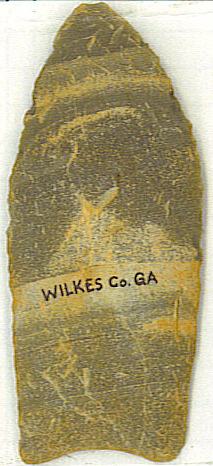|
MY FIRST PALEO
|
Jim McAvoy
|
| Central States Archaeological Societies 2003
Spring Journal |
Athens, Georgia
|
I have been searching for and collecting artifacts for almost six years. My first artifacts were found on my father's
farm when I was a boy. I placed them in a box which remained stored away until about six years ago, when my interest
in artifacts was renewed, partly out of a personal interest and fascination with history and archaeology and partly
by meeting a co-worker who is now my "arrowhead hunting" buddy and best friend. Kelly and I go hunting
together whenever and wherever we can. Since we have started, our collections have grown considerably, although
not as fast as we would like. My collection is mediocre at best with only a handful of exceptional artifacts, but
I consider any collection of any type artifacts a prize. They are all remnants of a time and people long past,
pieces of human life and activity buried in the earth. Through scientific research we try to piece together what
we find to tell part of the story, but most is left to the imagination. I think that is one aspect of archaeology
that makes this hobby so fascinating.

I have been fortunate enough, however, to find a few pieces that stand out above the rest. This is the story of
one of those pieces. It was mid May and the weather had already turned hot, as it usually does this time of year
in Georgia. I had already been told about a plowed tract of land a few weeks earlier and had been granted permission
to hunt on it but had spent time hunting other areas until now. Today I followed the directions I had been given
and found the tract, which consisted of a large logging area that had recently been plowed. Unfortunately my buddy
Kelly could not go with me on this day, so I was alone in my efforts. I started out in my usual manner by doing
a fast "scouting out" of the area, quickly walking over each hill or bottom that looked like a promising
site. I was having little luck.
As I walked downhill on a slope leading to a creek bottom, I found a small, field grade quartz point. It was intact
but rather crude, but at least I had another whole point to add to my collection. As I said before, any artifact
is a prize. By the time I reached the bottom of the slope nothing else had turned up. I had covered almost all
of the area and had not found any signs other than the one quartz point. There were no flakes or debris denoting
any kind of activity in the area. I was rather disappointed but decided to call it a day and return home. As I
walked back up the slope I continued to search. About halfway up the slope I spotted a piece of smooth, gray stone
partially exposed in the soil. My imagination ran wild as I started picturing my first axe or celt. As I pulled
the stone from the ground I was able to examine it. After a short examination I realized, with disappointment,
that it wasn't any kind of artifact at all. I dropped it back onto the plowed earth. I took one or two more steps
forward and suddenly my eyes froze on something right on top of the plowed row just in front of me. My heart rate
must have jumped, as I could hardly believe my eyes. There before me, totally exposed from past rains, was a fully
intact Clovis point! I picked it up and began to examine it. It was absolutely beautiful. I still had trouble believing
it. Even though Clovis points do exist over most of North America, they are very rare to find as surface finds
in this area, as was my case, and even rarer to be fully intact. There was a very small nick or fracture at one
of the basal corners, exposing the unpatinated stone underneath. This was a fresh fracture, obviously caused by
the plow. Just think if it had been broken.
Needless to say, I held the point carefully in my hand all the way back to the car. As soon as I arrived home I
cleaned the point as best I could and continued to examine it the rest of the evening. I called Kelly to tell him
about my incredible luck. The point measures 3 1/8 inches long by 1 5/16 inches wide. It is made of what I believe
to be banded, gray rhyolite. It has apparently been resharpened on one side near the tip. Also, of interesting
significance is the fluting. At first I thought this point to be an unfluted Clovis, which, to my knowledge, is
very rare. But this point actually is fluted, but very slightly. The fluting is only noticeable if one manipulates
the light and shadows until the fluting can be seen. I am by no means an expert, so I would appreciate any comments
or ideas about the typology of this point.
Ever since I have wondered about the person who lost this point so long ago. What must life have been like for
that human, struggling for survival? How long ago was it? What was that area of land like then? Was it nearly covered
in water or dry? Was it hot or cold? What animals were there to be hunted? Perhaps we will never know the answers
to most of these questions, but it is fascinating to imagine. Happy hunting!
|
Copyright © C.S.A.S.I.
|




